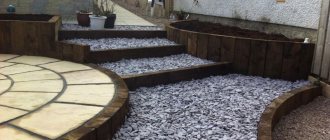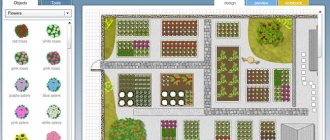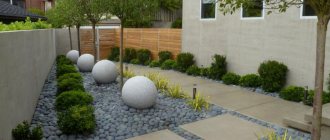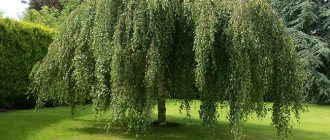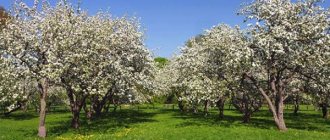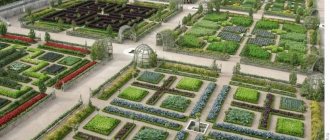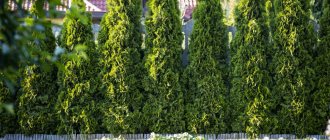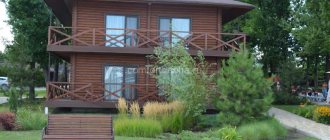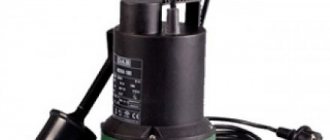Not everyone has room in their yard for a giant ship pine or huge oak tree. But fortunately, there are many dwarf trees suitable for small gardens. Such trees usually grow no more than 4-4.5 meters in height. Not only do they fit easily into landscape designs, but they are also less labor-intensive to maintain than large trees. In this article I would like to talk about my favorite short trees that are worth paying attention to when landscaping a small garden.
Popular short trees for landscape design
Advantages of short trees
Although dwarf trees are small in size, they can still make a big contribution to the landscape. We love dwarf breeds for their miniature size, unique shapes and, of course, the color of their foliage or flowers. When choosing trees for small gardens, it is essential to find out the maximum height of the tree and how long it will take for it to reach that height. Some species grow slowly and initially fit very well into a small garden. But over time, they can grow too large and take up all the available space, blocking light and potentially damaging the foundation of your home.
Fortunately, there are many species and cultivars of trees that are compact in size and remain compact throughout their lives. A correctly selected and well-placed tree will become an attractive center of attention and will arouse interest throughout the year. Pruning is usually an easier task in this case.
If you have a small yard, focus your attention on vertical space. That is, choose plants that grow upright and have a narrow crown to make the most of the available space.
In addition to decorative foliage plants that will brighten the garden all season long, or beautiful flowering plants that produce a wave of blooms in spring or early summer, look for trees with berries to attract birds and provide them with nesting sites.
If you don't know where to place your tree, growing it in a pot may be a solution. In this case, you can place it in different places and take it with you if you move. This growing method is also useful if you need to protect a heat-loving tree in winter by moving it to a frost-free room.
How to care for a fruit “mini garden”
The basic rules of care include systematic loosening of the soil, removal of weeds and other vegetation. To avoid the appearance of crusts on the ground, you will need to mulch the soil. Compost is used for such purposes.
Particular attention is paid to the soil during the dry season. To retain moisture, the soil is covered with hay. Mulching is carried out so that the layer is not located too close to the trunk. It is not recommended to apply mulch during wet periods.
Watering
It is recommended to water the mini garden weekly. 2 buckets of water should be added to 1 seedling.
Fertilizers
It is best to fertilize after the soil is moistened. For dwarf plantings, fertilizing with mullein or chicken manure is ideal. It is recommended to dilute mullein with water in a ratio of 1 to 10, and chicken droppings - 1 to 20.
Diseases
Most often, gardeners encounter powdery mildew, mosaic and cytosporosis. The first disease manifests itself in the form of a white powdery coating. This is a fungal disease that progresses quite quickly. Fruits on such trees may not bear fruit and may become deformed. As preventive methods, it is recommended to carry out systematic pruning, remove debris and fallen fruits. Thickening of the crown is not allowed. In spring, it is recommended to spray with Bordeaux mixture. If the plant is damaged, it is recommended to remove all damaged parts and burn them. It is also recommended to use the preparations “Tiovit Jet”, “Topaz”, “Quadris” for treatment.
Mosaic appears as green or white spots on leaves and fruits. This is a disease of viral origin. Leaves may become deformed and development may slow down. Often the disease occurs due to treatment with instruments that are not disinfected. Minor damage can be treated with Karbofos.
Cytosporosis is manifested by brown shades of the crown, the appearance of bumps and roughness. Treatment will only help in the early stages. All damaged areas are removed and burned. Then the trees are treated with Bordeaux mixture, also fed with ash and whitened with lime.
Properly selected dwarf trees for the garden will harmoniously complement a small area, fill it with beauty and provide fruit.
Ash maple "Flamingo"
Flamingo ' is a delightful little tree. Its young leaves turn bright pink in spring before turning green with a bright pink edge, which subsequently fades to creamy white, retaining a very light pink tint.
Unlike the common ash-leaved (American) maple in urban landscaping, this variety is not very winter-hardy and never grows tall. In the middle zone, it is usually grown as a coppice crop, that is, having frosted over this small tree (up to 5 m tall), it is restored from the root in the spring, remaining the size of a bush (2-2.5 m).
The lighter, brightly colored maple foliage contrasts well with darker coniferous or deciduous plants and flowers. Suitable for all soil types as long as good drainage is provided. Can be grown in full sun or partial shade. Trimming improves foliage color.
Acer negundo 'Flamingo'. © hopesgrovenurseries
Flowering shrubs for hedges
Mahonia holly
photo: Mahonia holly hedge
Belongs to the barberry family. A spectacular fast-growing shrub for hedges, up to 2 meters high. The designers also nicknamed it the holly grape for its characteristic carved leaves. In spring and summer they are green, and in autumn they turn bronze-red. Flowering occurs at the end of spring. The inflorescences are large and yellow. In a year, mahonia can grow by 20-25 cm.
Forsythia
photo: Forsythia hedge
Such hedge bushes will decorate any area. In early spring, the plant is covered with golden inflorescences. Flowering continues from late April to June. The branches are long and graceful, growing up to 2 meters. Forsythia needs to be covered for the winter. The best place for landing is a well-lit area. In the shade the bush will bloom weakly. Pruning is done annually. Recommended varieties: oval-leaved, European, Giralda.
Barberry Thunberg
photo: Thunberg barberry hedge
The name of the hedge bush was given in honor of the Swedish naturalist Carl Thunberg. This subspecies of barberry reaches a height of 2.5 meters. Loves the sun and grows quickly. Foliage can be golden brown, purple, green, burgundy. It blooms with white inflorescences in May, and fruits form at the end of August. The barberry crown is dense, making the hedge dense. There are dwarf varieties for border landscaping.
Decorative apple trees
Add dramatic seasonal color to your landscape with ornamental apple trees (Malus). This group includes plants with purple foliage, carved leaves, but their main decoration is flowers in various shades of white, pink and red, and in the fall they bear orange, gold, red or burgundy fruits. One of the most popular varieties of ornamental apple tree "Royalty" with dark pink flowers, reddish-purple foliage and high disease resistance.
Decorative apple trees have a weeping, round or columnar crown shape. The height of such apple trees can vary, but usually does not exceed 4 m. Growing conditions are open sun, average humidity, well-drained soil. In some varieties of ornamental apple trees, the fruits may be edible, but they are often tasteless or even cause symptoms of poisoning, which must always be taken into account.
Ornamental apple tree (Malus), variety “Royalty”. © Sylvi
Beautiful examples
An expressive example of a flowering ornamental shrub is shown in the photo. Flowers raised to different heights look very original. But the main advantages of this composition are associated with the stems of the crops included in it.
And here the design effect was used using a thick pink carpet. With its help, you can transform a nondescript gray wooden fence and add elegance to it.
A composition of flowering shrubs can look extremely original. Here is a lush, squat carpet of white flowers. On the left is just a green mass, and in the middle is a neutral gray stone. This winding path serves as a good visual divider.
For more information on caring for and growing ornamental shrubs, see below.
Iva "Hakuro Nishiki"
Hakuro Nishiki is the ideal plant to liven up dull spaces and give them an attractive appearance. The rounded silhouette of this miniature tree makes it an excellent accent plant. A problem-free large bush or small tree (up to 3 m tall), which grows quickly and will become a real highlight of the landscape. It stands out for its bright, color-changing leaves, thanks to which the bush may appear pink from a distance.
The young leaves of this willow are pink in spring, after which they turn white and green, and by autumn they turn yellow. One of the best qualities of this shrub, besides its color, is the soothing sound the leaves make when the wind blows over them.
The Hakuro-Nishiki willow is considered a low-maintenance shrub and can be easily grown in fertile soils that are well drained but constantly moist. Although it tolerates drier soils compared to other willows, it still requires regular moisture. This willow lends itself well to pruning. You can also often see it on sale in the form of a grafted tree on a trunk.
The only problem that can arise with such a willow is partial freezing of the branches in a harsh winter, however, the tree quickly recovers.
Willow whole leaf "Hakuro Nishiki" (Salix Integra Hakuro Nishiki)
Read also our article Variegated willows in my garden are beautiful at any time of the year.
Trimming hedge bushes
Haircut and pruning are basic hedge care activities. They help preserve the beauty of the composition and the health of the plants. It is very important to perform pruning at a strictly established period for each shrub, otherwise you can simply destroy the plant.
First pruning of bushes in a hedge
Trimming after planting promotes the development of a strong root system and stimulates shoot growth:
- For deciduous plants. During the pruning process, dry and weak shoots are removed. A spreading bush is cut at a height of 35-40 cm, weak plants - at a height of 15 cm. Approximately 1/3 of the length of the seedlings is left. If the hedge was planted in the fall, pruning is done in the spring. A hedge formed in spring or summer can be tidied up after planting.
- For coniferous plants. These shrubs have well-formed crowns, so they are not pruned in the first year. If necessary, only damaged and dried shoots are removed in July-August.
| Shrubs | Trim time | How to trim | |
| Krona | Lateral sprouts | ||
| Deciduous | If planted in autumn, prune in spring; If planted in spring/summer - a week after planting | 30 – 35 cm above the ground | 15 cm |
| Conifers | July - early August, no earlier than a year after planting | The tops are cut off by 10-15 cm | 5-10 cm |
Useful tips for gardeners
- If the hedge has a complex shape, it is better for beginners to cut it according to a template - it is made from cardboard or chipboard.
- Coniferous hedges are pruned in July-August. In the fall, the shoots are not touched, otherwise they may not have time to come into force and will suffer from the cold.
- If you trim your hedge frequently, you will need to apply fertilizer. The optimal period is early spring. You can use both compost and multi-component fertilizers.
- You will need the following tools: pruning shears, loppers (for thick branches), electric shears (for forming a hedge). It is important that the tool fits comfortably in your hand and is not heavy.
Pruning when the hedge has grown
To make the hedge look neat and well-groomed, it needs to be trimmed. Deciduous bushes are pruned twice a year, coniferous bushes - once a year as necessary (if the plants do not grow well). If the hedge is unshaped, it is enough to trim it in the spring. Then the branches will grow thicker, but the shape of the bush will remain natural.
Molded deciduous hedges are trimmed once a month. Coniferous - twice a year, in spring and summer. Columnar-shaped shrubs are practically not pruned. Once every few years, thinning the crowns of deciduous plants is carried out - this procedure should be carried out in early spring before the buds appear. Old shoots are removed, and new shoots are cut by a third.
Important! You need to understand the difference between cutting and trimming. Trimming is simply maintaining the desired shape of the hedge, pruning is a procedure for caring for the plant. Pruning involves removing excess branches for more intensive growth and density.
Alder buckthorn "Fastigiata"
Alder buckthorn "Fastigiata" (Frangula alnus 'Fastigiata', Ron Williams) is an original compact tree with a columnar crown, which from a distance can resemble a cypress. This is a persistent, hardy plant that does not require special care. The slow-growing tree is often grown as an addition to Japanese gardens or as the centerpiece of small arrangements. In adulthood it reaches a height of about 2.5 m.
The leaves are narrow, light green in summer and bright yellow in autumn. The bark is interesting for its bright color, so the tree is beautiful even after the leaves have fallen. Can grow in full sun, but develops better in partial shade. The breed is so frost-resistant that it can easily be grown in open ground or in containers (frost-resistant down to -40 °C). Almost any soil is suitable for buckthorn, except swampy ones.
Alder buckthorn "Fastigiata" (Frangula alnus 'Fastigiata', Ron Williams). © springmeadownursery
Principles of arrangement of trees in the garden, their combination with other plants
When planning a garden, the following categories are used:
- standard - usually medium or low, with a crown close to a ball in shape;
- various deciduous weeping species;
- dwarf fruit, deciduous trees;
- columnar hybrids.
Trees are arranged in one or two rows, singly, according to a certain pattern, in groups of an odd number of representatives of the same, different species. You can form so-called bosquets - mini-groves, which, with the help of haircuts, are formed into dense “living fences”, using both coniferous and deciduous species.
In the presence of large free spaces, some trees are used as tapeworms - light-loving plants planted in an open area. Often they use it to split the trunk so that the tree is as branched, spreading, and low-slung as possible. In some cases, gardeners, using special techniques, form spherical, conical, umbrella, pyramidal, and weeping crowns. Less often, several identical plants are planted close to each other, gradually they almost grow together, and from a distance they look like one.
It is also important to correctly combine elements of green spaces with each other - not all plants are friends. For example, jasmine, lilac, fir, horse chestnut have a detrimental effect on the development of pear and apple trees, and it is better not to plant anything next to mulberry or sea buckthorn
Most fruit crops do not tolerate proximity to birch, maple, and many conifers. Pines, spruce, and fir strongly acidify the soil, which is unacceptable for stone fruit and pome-bearing species. If there is oak, willow, or poplar in the garden, their fallen leaves should be removed before they begin to decompose. Certain tree species contain phytotoxins that are released into the air - while harmless to people, they seriously harm other vegetation.
Rowan
Most mountain ash (Sorbus) have beautiful feathery leaves, snow-white spring inflorescences and bright autumn berries. These are excellent trees for attracting garden birds such as robins and blackbirds. They like rowan berries, which are rich in nutrients.
An excellent choice for a small garden would be sweet-fruited varieties of rowan, which do not grow large and have a very original appearance. For example, the rowan "Pomegranate" with very large burgundy-red edible fruits does not exceed 4 m. Or the rowan "Titan" with sweet and sour cherry-red berries, 3 m high. The variety "Pendula" is a real sculpture in the garden, so how this weeping rowan forms strange shapes on a trunk and does not grow tall.
I also advise you to pay attention to the Kene rowan or its relative Kashmir , which amaze the imagination with snow-white or slightly pinkish fruits. The foliage of this rowan tree is more delicate and bright red in autumn. Often found grafted onto a standard. The height of the tree is 3-4 m.
Rowan (Sorbus aucuparia), variety "Pendula". © Floraplanet
Rowan (Sorbus), variety "Titan". © praskac
Rowan Koehneana (Sorbus koehneana). © Oregon State University
Ficus
There are more than 20 species of domestic trees in the Ficus genus. They vary in shape and appearance. This undemanding plant does not require frequent watering and does not need nutrients. It purifies the air well, neutralizing benzene-formaldehyde and other pollutants. Some ficus plants are poisonous. They should not be kept in a home where there are children or pets.
Ficus succinatus produces volatile substances that are deadly to asthmatics. Not recommended for bedrooms and children's rooms.
Ficus succinatus looks great in an interior with large, lush green trees that form a dense crown. The following varieties of ficus are suitable for home interiors:
- Ficus binnendica;
- lyre-shaped;
- ampelik;
- Bengal;
- rubber bearing;
- in the shape of a bottle.
- Ficus benjamina;
- dwarf;
Ficus is one of the most popular indoor plants. It can often be found in apartments and offices. To keep the plant looking healthy, it is enough to water it generously from time to time.
Hazel
Fruit varieties of hazel or hazelnut ( Corylus avellana
), which are grown mainly for their nuts, are also usually small trees 3-4.5 m and are well suited for small gardens, although it must be borne in mind that they usually have a fairly wide crown.
Decorative varieties of hazel grow more slowly and are more compact; in addition, they usually have a very original appearance. For example, hazel "Contorta" with twisted branches and deformed green leaves. Or "Red Majestic" hazel, which also has twisted branches and clenched leaves that are bright red. Both trees do not exceed 3 m.
The Pendula hazel has a very unusual appearance of an umbrella or hut with a weeping crown, which has a height of 2 m and a width of 2.5 m. The decorative hazel Aurea , 3 m high, which can become a good partner for numerous red-leaved varieties hazelnuts
Hazel prefers fertile, moisture-absorbing soils and does not grow well in dry conditions. The place should be sunny or slightly shady.
Hazel or hazelnut (Corylus avellana), variety "Red Majestic". © The National Gardening Association
Characteristics and features of hedge shrubs
| Shrub name | Difficulty of care | Evergreen or not | Flowering | Perennial | Notes |
| Dogwood | Average | No | Yes | Yes | There are more than 50 species of dogwood. Grows quickly. |
| Bladderwort | Simple | No | Yes | Yes | About 20 varieties. Fast growing. |
| Snowberry | Simple | No | Yes | Yes | 15 types of shrubs. Refers to fast growing. |
| Thuja | Average | Yes | No | Yes | More than 100 varieties. It grows slowly. |
| Boxwood | Simple | Yes | No | Yes | More than 100 species. The shrub grows slowly. |
| Juniper | Simple | Yes | No | Yes | About 70 species are found in nature, of which 15 are cultivated. It grows slowly. |
| Kalmiya | Average | Yes | Yes | Yes | There are 10 species of shrubs belonging to this genus. Grows quickly. |
| Spirea | Simple | No | Yes | Yes | There are 90 species of spirea. It has spectacular flowering. |
| Caragana shrub | Simple | No | Yes | There are annual and perennial varieties | The genus Caragana includes 70 species. Growing actively. |
| Derain | Simple | No | Yes | Yes | More than 10 types. Grows at an average speed. |
| Rose hip | Average | No | Yes | There are annual and perennial varieties | More than 50 species grow in Russia, and there are more than 300 in the world. It grows quickly. |
| Blackberry | Simple | No | Yes | There are annual and perennial varieties | More than 200 species. Grows quickly, needs additional support. |
| Mahonia | Average | Yes | Yes | Yes | More than 50 types of mahonia. It grows slowly. |
| Forsythia | Complex | No | Yes | Yes | There are 6 known types of forsythia, the most popular is European. It grows slowly. |
| Barberry | Simple | There are deciduous and evergreen varieties | Yes | Yes | More than 100 types of barberry. Unpretentious, grows quickly. |
Dwarf conifers
Conifers can make excellent dwarf ornamental trees. They can be easily trimmed and trained to remain short throughout their lives. Small specimens can be found in almost all popular coniferous tree species.
For example, thujas with a columnar crown for small areas: “Yellow Ribbon” (4 m), “Sunkist” (3 m), “Rheingold” (2-3 m), “Malogna Holub” (1 m), “Holmstrup” ( 3 m), "Green Egg" (2 m).
Hibiscus
The Chinese rose thrives in apartments and offices. With proper care, it can reach a height of 1.5-2 meters. Chinese hibiscus is a long-lived plant. In favorable conditions it lives for several decades. Large green branches forming the crown are its decoration. With proper care, the Chinese rose will repay its owner with beautiful flowers. Hibiscus flowers are variegated and have large petals. The Chinese rose is easy to care for. Regular watering and sprinkling are sufficient for proper growth. Hibiscus can grow under artificial light, in rooms completely devoid of natural light.
Louisiana three-lobed
Louisiana three-lobed, or almond, or three-lobed plum (Prunus triloba) is a stunning analogue of sakura for the middle zone. It is a small dense, round, multi-stemmed tree 2-3 m high (but if necessary, it can be easily maintained at half this height by trimming).
At the end of April-May the tree becomes unusually beautiful. Pink double or semi-double flowers with a diameter of up to 4 cm bloom on it, which densely adhere to the entire upper part of the crown, as if glued to the branches. The tree also has an autumn yellow-bronze color.
Louisiana's leaves, elongated oval in shape with finely toothed edges, provide light shade during the summer months for perennials growing under its canopy. The tree will withstand the harshest winters and is resistant to most pests and diseases.
An avenue of blooming almond trees will create an impressive border along a walkway, patio or lawn, and the tree will look great in a garden pot.
Triloba plum is best grown in moist, fertile, well-drained loam in full sun or partial shade (blooms best in full sun). Monnilia can sometimes become a problem, but hybrids with plum species are not severely affected by this disease.
Louisiana triloba, or almond, or triloba plum (Prunus triloba)
Dear readers! If you're looking for a small tree for a small garden, also consider shrubs. Many tolerate pruning well and can be raised to give the appearance of a small tree. But at the same time, they will be lower than many trees, reaching a height of 3-3.5 m. Try this, for example, with viburnum, lilac, dogwood, bladderwort, paniculata hydrangea or elderberry.
Evergreen shrubs for hedges
Thuja
photo: Thuja Brabant hedge
There are more than 100 varieties of thuja, but two are used for hedges: Brabant and Smaragd. Brabant has a pronounced cone-shaped crown, the height of the bush is up to 4 meters. Thuja grows 25-30 centimeters per year. Smaragd is less branched, growing by 20 cm per year. They love well-lit spaces; young plants need to be covered for the winter. To get a dense hedge, thujas are planted at a distance of 50-70 cm.
photo: Thuja Smaragd hedge
Boxwood
photo: Boxwood hedge
It grows quite slowly - up to 15-20 cm per year, but attracts gardeners with its decorative qualities and unpretentiousness. Boxwood produces a dense green hedge of regular geometric shape. Height – up to 1 meter. It takes root easily and loves warmth. If the cottage is located in a cold region, the boxwood will grow small. In severe frosts, shrubs need to be covered.
photo: Boxwood easily takes and “holds” geometric shapes
Important! Hedging shrubs such as boxwood are poisonous, so it is not advisable to choose it if there are small children in the family.
Juniper
photo: Juniper hedge
A shade-loving plant that tolerates winter well. Juniper does not need to be watered often; it is unpretentious to the quality of the soil. For hedges, it is better to choose cone-shaped varieties. Spreading ones are used to decorate borders. It grows by 20 cm per year, the height of the bush is up to 1.5 meters. Berries appear on plants older than 2 years. Planted in a checkerboard pattern, the distance between plants is at least 60 cm.
Laurel
In an apartment, laurel can grow even with a lack of lighting; it is not afraid of drought and drafts. It is easy to care for. With moderate watering, the laurel will delight with greenery all year round. The fragrant leaves can be used as a seasoning in cooking.
Homemade laurel is not afraid of diseases and pests. In a cozy environment, the giant grows up to 15 meters. Curly pruning will help limit excessive growth. At home, laurel lives 12-15 years. In order for the bush to form a lush crown, it is trimmed starting from the age of five. The following varieties of decorative laurel are distinguished:
- noble;
- Canarian.
Noble laurel exudes a pleasant tart aroma. But the Canarian has beautiful wide leaves. Botanical varieties look great in urban interiors.
Monstera
The evergreen monstera was brought here from South America. When young, the plant looks like a bush, covered with large leathery leaves, which over time become covered with slits and holes. Many people believe that monstera does not bloom. This is wrong. This tropical beauty rarely blooms. The monstera flower is a dense white bud with a variegated, corncob-like fruit inside.
Monstera is easy to care for. It requires regular watering and sprinkling. As a shade-loving plant, it does not tolerate direct sunlight, so it should be kept away from south-facing windows. Also keep in mind that monsters don't like to be moved from place to place.
Bonsai
It is a miniature copy of a tree. The idea of growing gnomes in pots came to us from China. Asian bonsai is not just a small flower in a pot. This is a work of art and the embodiment of living sculpture. Growing miniature trees is a kind of ritual to create a smaller copy of nature.
Growing bonsai requires a lot of skill and patience. Coniferous, fruit trees and specimens with small, fluffy leaves are suitable for cultivation. Beautiful bonsai trees are made from climbing willows and birches. The rooted seedling is planted in a pot. Grass is sown around it for aesthetics. For several years, the spruce or birch tree will be well looked after, giving it the desired shape. This is achieved by pruning old branches and cutting off new shoots. In this case, the bonsai should be watered at the right time and fed as needed. By observing the shoots and regulating their growth, you will eventually end up with a graceful mini dwarf tree.
Citrus trees
Grown at home in large boxes and pots. According to Feng Shui, they bring good luck and prosperity to the home. Citrus trees can be propagated by seeds and cuttings. They are easy to care for. Regular watering, sprinkling and fertilizing once a year is sufficient. Lemon and orange seedlings need pruning. There are several varieties suitable for growing at home. The most popular of them are the following:
- tangerine tree;
- calamondin;
- grapefruit;
- lemon;
- citron.
In order for exotic citrus fruits to bear fruit successfully, it is necessary to create ideal conditions: optimal temperature, constant humidity, regular fertilization of the fruit tree and light during the winter months. Grafting is necessary for successful fruiting.
